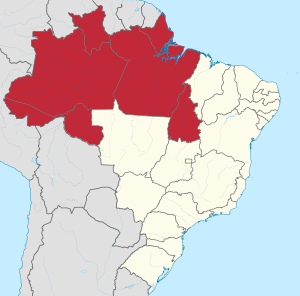
O North of Brazil is the largest region in the country, with an area of 3,853,843.7 km² (46.25%) and the second smallest in population, with 17,707,783 inhabitants (8.6%) in 2016. It is located in the geoeconomic region of Amazon, enter theGuyana Massif (to the north), theCentral Plateau (to the south), theAndes mountain range (to the west) and the Atlantic Ocean (to the northeast).
Understand
The 17th century marks the arrival of the Portuguese to the place, where they built military forts to defend the region against the invasion of other peoples, in 1616, leading to the foundation ofBethlehem. The riches of the Amazon Forest also came to be of interest to the Portuguese Crown. With the Portuguese explorers, Catholic missionaries came to the region, with the aim of catechizing the Indians. The Indians were gathered by the missionaries in villages, called missions, and many of them gave rise to various cities, such asBorb andObidos.
Climate
The predominant climate in the region is equatorial, in addition to some regions with a tropical climate. The region is dominated by an important ecosystem for the planet: aAmazon.
States and capitals

| Acre - AC (capital White River) A small state with a mixture of cultures and cuisines, brought by the rubber and chestnut trees that attracted people from all over the country. |
| Amapá - AP (capital Macapa) Beaches, marshes and jungle. Unexplored forests cover most of the area of this state. |
| Amazons - AM (capital Manaus) Two words: Amazon forest. This is the largest state in Brazil by area, and is almost entirely covered by the Amazon. |
| For - PA (capital Bethlehem) Lots of forest here too, as well as a strong indigenous culture and one of the biggest Catholic parades in the world. |
| Rondônia - RO (capital Porto Velho) Previously, it was a center of Amazon deforestation but clear cuts have slowed, leaving Rondônia an out-of-the-way destination, with countless indigenous territories and opportunities for adventure in the rainforest. |
| Roraima - RR (capital Good view) squeezed between the Venezuela and the Guyana, this state is sparsely populated, but has landscapes that range from forest to grassland and mountains. |
| Tocantins - TO (capital palms) River oasis, colonial cities and a national park on a large river island. |
Cities
- Guajará-Mirim (RO) - Contains natural attractions such as rivers, preserved forests, spas and parks.
- Nativity (TO) - oldest city in the state and has numerous 17th century colonial houses, still well preserved today.
- New Airão (AM) - ecological city at the entrance of the Jaú National Park.
- Parintins (AM) - known mainly for hosting the Folklore Festival of Parintins, the traditional Feast of the Oxen.
- President Figueiredo (AM) - city sought by the Cachoeira Santuário Ecological Reserve.
- Salinopolis (PA) - Also known as Salinas, its beaches have fine white sand, with gray-green waters.
- Santarem (PA) - considered the Pearl of Tapajós.
Other destinations

- cotton (PA) - also known as Maiandua Island.
- Alter of the Floor (PA) - popularly known asBrazilian Caribbean, as it houses the most beautiful freshwater beach in the world.
- Marajó Island (PA) - is the largest coastal island in Brazil, and also considered to be the largest fluvial-marine island in the world, as it is bathed, at the same time, by both river and ocean waters.
- Mosque Island (PA) - offers countless beaches, with excellent infrastructure and wonderful landscapes.
- Jalapão State Park (TO) - One of its characteristics is the production of golden grass and buriti silk handicrafts.
- Anavilhanas National Park (AM) - covering about 400 islands, it is located on the Negro river.
- Araguaia National Park (TO) - consisting of several species of fauna, in addition to a very diversified vegetation cover, featuring various natural scenarios of rare beauty.
- Jaú National Park (AM) - has the exuberance of the Amazon Forest and all its biodiversity of flora and fauna.
Arriving: Plane: Arrive at Manaus Airport (Eduardo Gomes International Airport)
Belem Val de Cans International Airport, Palmas Airport, São Gabriel da Cachoeira Airport, Rio Branco International Airport, Governador Jorge Teixeira International Airport...
Get around: By boat, on foot and by jeep (4x4)
Speak
Buy
Eat: eat fish with açai and Brazil nuts
drink and go out
sleep
Learn
Safety
Health
It is highly advisable to take a vaccine against yellow fever, as there are outbreaks of the disease throughout the region.
respect
Always be careful not to leave bottles, plastic bags or waste in the way. Bring it back until you find a Dumpster.
Stay in touch
Before going to places further away from the cities, it is advisable to let your destination know; always have a cell phone handy.
Leave
| This article is outlined and need more content. It already follows a suitable model but does not contain enough information. Plunge forward and help it grow ! |

